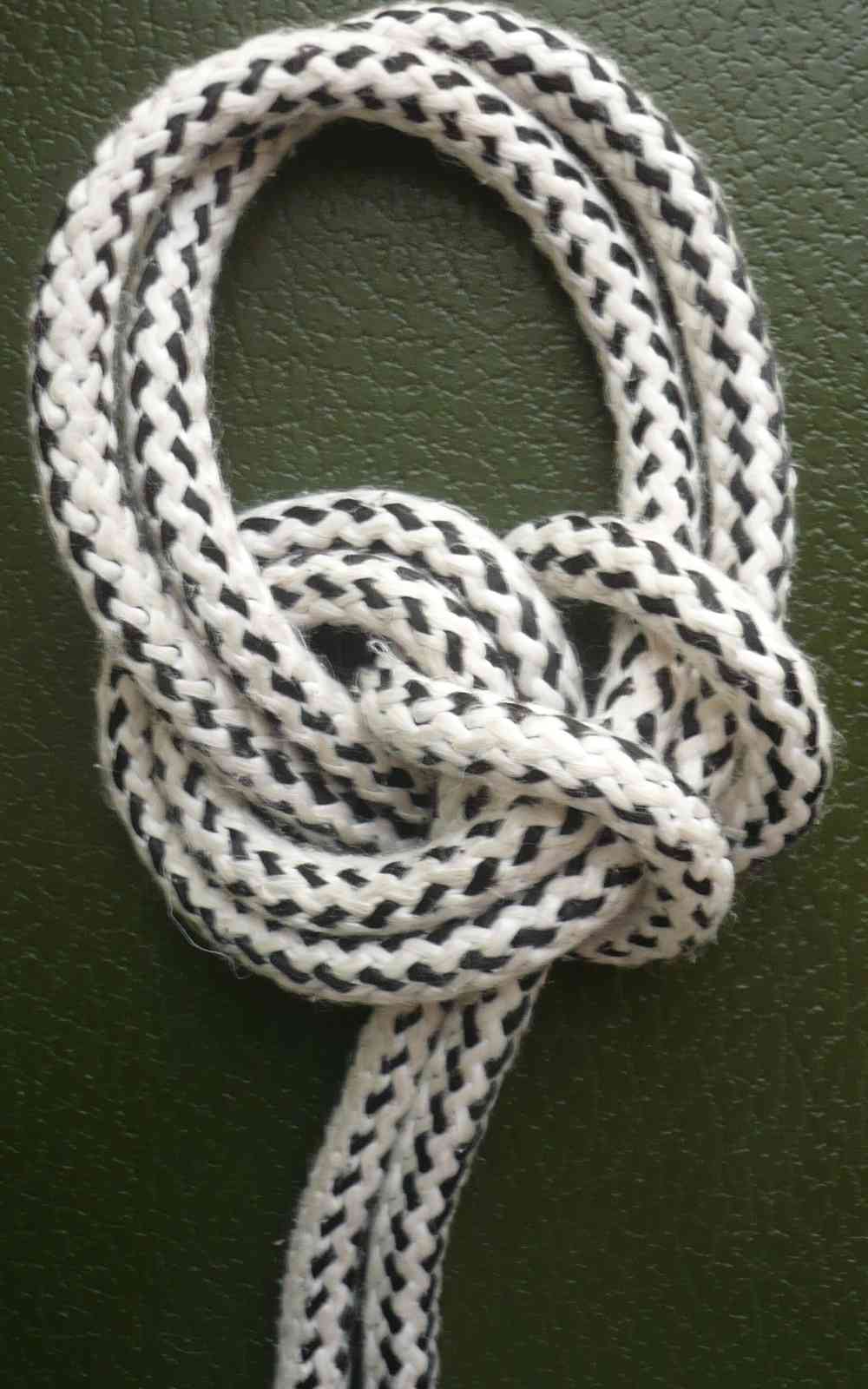I think that the TIB double bowline shown in the attached pictures ( where the collar does not collars the Standing/Tail End pair, as in the double bowline on-the-bight, but the rim of the double-line nipping loop ), is an interesting knot, because of its wide nipping loop, but also because, easily and quickly, by just making one of the two eyes shrink, we can transform it into a secure TIB single bowline with a nice, compact, self-dressing nub.
However, I can not find an easy to remember and to tie in-the-bight tying method - and I am not even sure that there is no such method. The members of the Forum who happen to like puzzles like this, are challenged to try their hand.
This is a clever knot --maybe, though, too clever by half;
or, at least, not without problematic issues. Like the
bowline on a bight, there is the issue of how to orient
the S.Parts vis-a-vis eyes (which flows into where),
and which S.Part to favor for single-strand loading!?
I’ve also tried this cleverness with a the bight-end
making a girth hitch (what it only points towards,
in this original), and of changing the structure to be
a similar one for the myrtle and bollard bowline
/anti-bowline --where vice a “proper collar” of a bight
around the S.Part, there is a loop around the nipping turn.
In some cases, the girth hitch part might see its
collar/bight end run through the nipping turn (and so
that bight could be cut into two tails) which gives four
diameters of material for the S.Parts to nip, and where
it does not.
As for TIB method(s), I don’t find a quick one,
working from tied-knot to untying it slowly, looking.
but that’s just a quick glance, really. --lots of intriguing
paths to take from this general idea!
–dl*
I got it! ![]()
I’m sorry for the quality of the pictures: It’s a rainy day!
bye,
s.
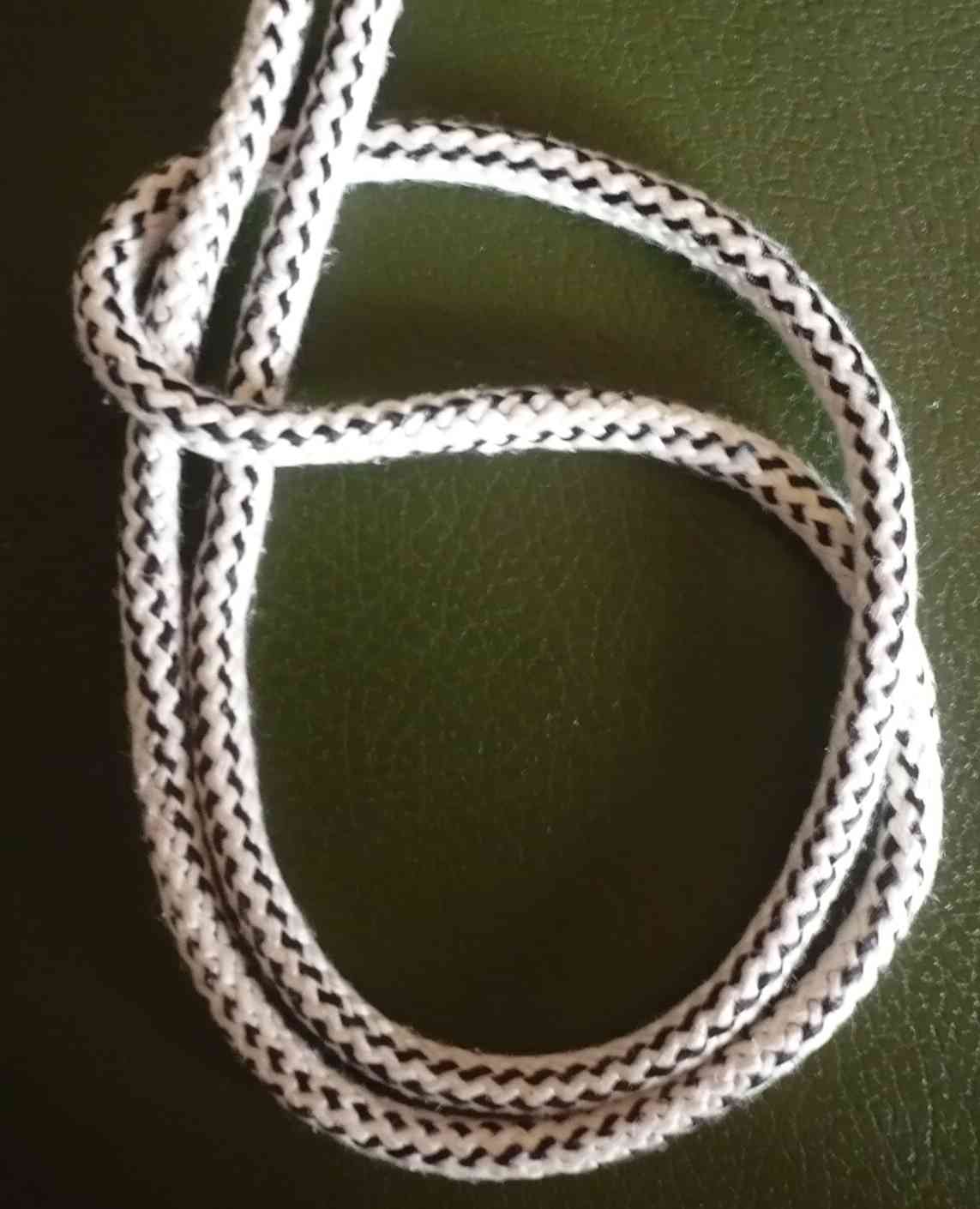
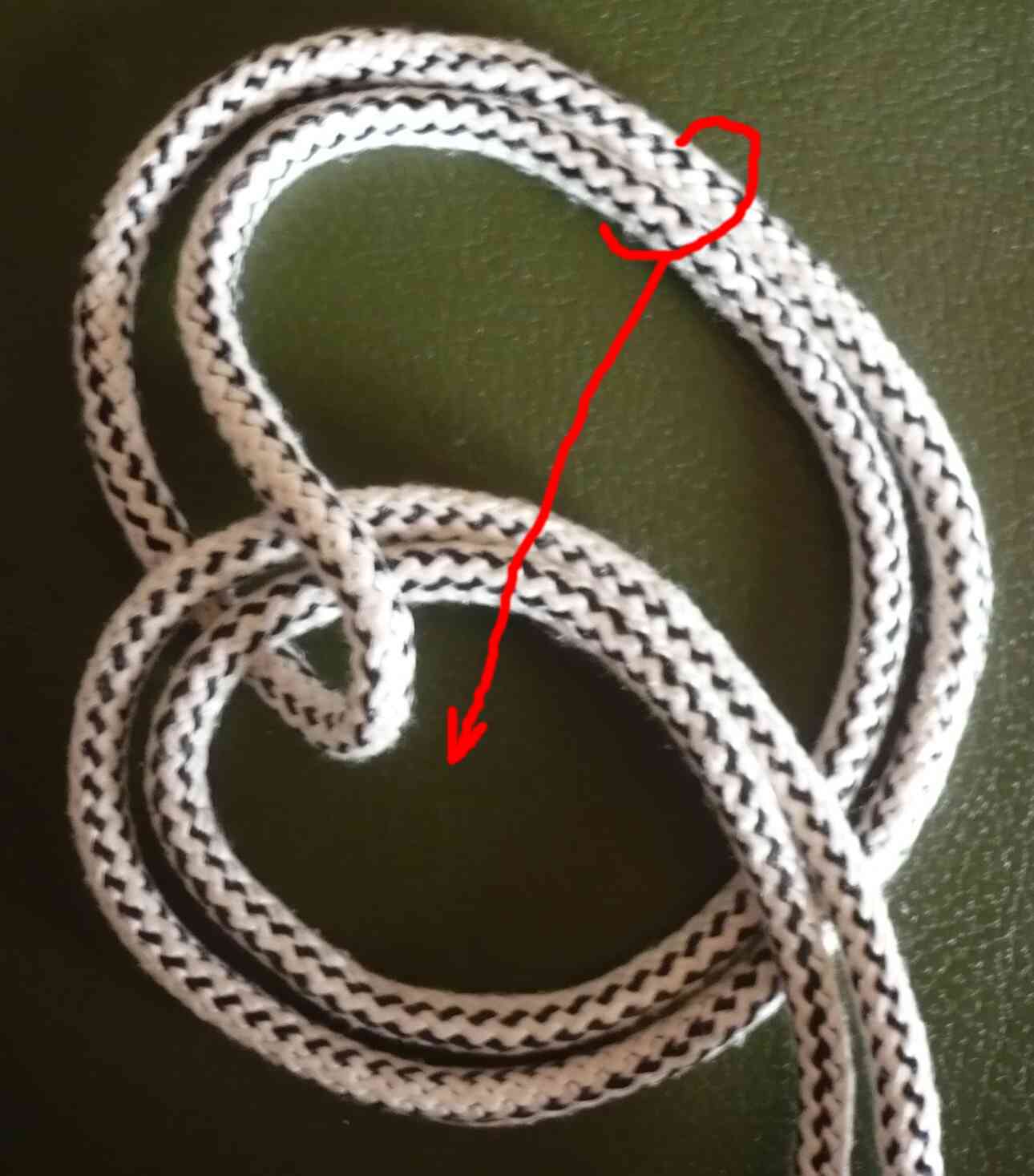
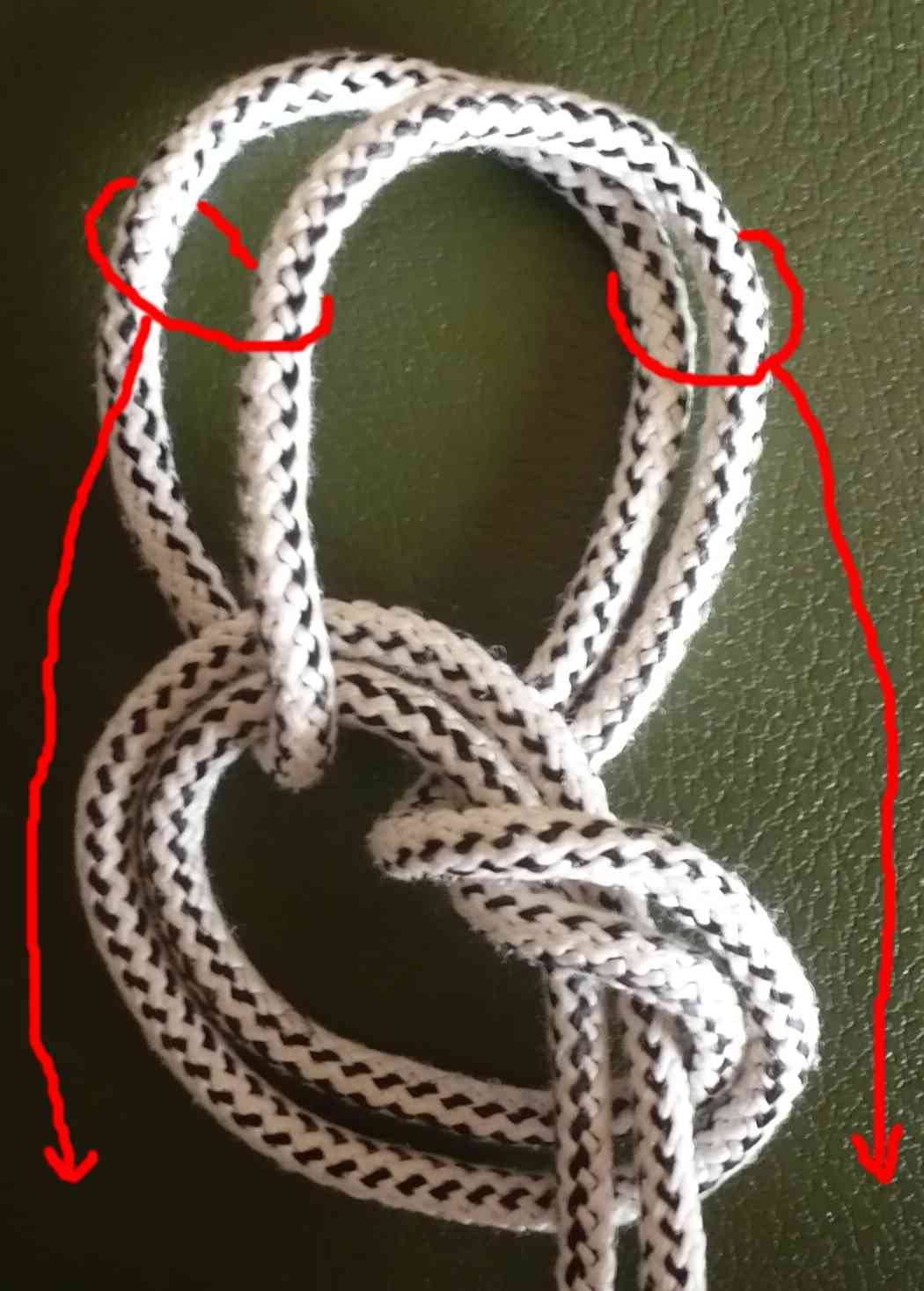
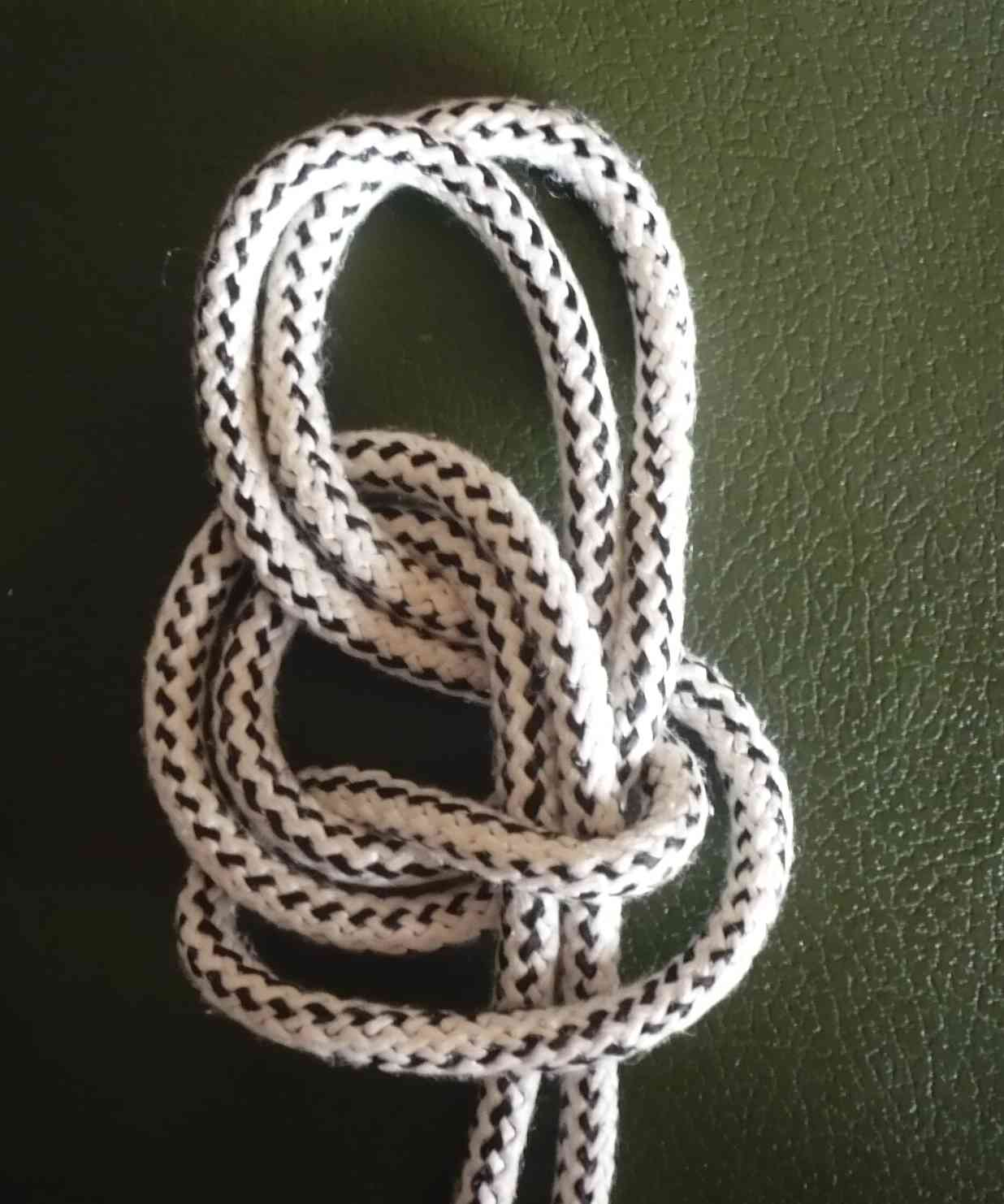
Congratulations !
Now, find a name for this bowline, any name you like - otherwise I will call it “Knotsaver s bowline” ! ![]()
I’ll keep silent… so you’ll call it “knotsaver” bowline! or simply “saver bowline” ![]()
I feel honoured, Xarax, but I only discovered a TIB tying method, I didn’t discover the knot
(nice knot! this is a clever (tricky?) double-strand left-hand bowline).
We can call it
“clever bowline” or
“tricky bowline” or
…
“Constant bowline” ![]()
or if you don’t like Constant… ???
“Carlito bowline”
or…
“Denise bowline”
or…
![]()
ciao,
s.
p.s.what about the clever double-strand right-hand bowline?
First, it is neither left- nor right-handed - simply because the line is not oriented : any of the two ends can be chosen/considered the Standing End or the Tail End, and this will determine the handedness of the bowline.
“Clever”, or “tricky”, are adjectives which characterize the knot tyer or what he thinks the one ( of the many ) methods he is tying the knot is, but not the knot itself. To me, your “twist” seems clever and tricky, indeed, but to somebody else it may seem elementary.
Knot tyers names are the most dumb names of all ! Let us try to be more clever than that.
Therefore, try again ! And we need ONE (=1) name, not the whole catalogue ! ![]()
( P.S. : If there was no easy/quick TIB method, or if nobody would had discovered it, this TIB knot, as all the others where TIB-ness is an essential advantage, would had remained useless as practical knots. Now, at least it has some chances… Do not underestimate the value of the discovery of a suitable tying method, in this case ).
In the single-eye loop, which is the more interesting, I would start from the knot itself : I think that it will form a more compact / neat / easily inspected nub, if we shrink the “closer to the viewer” eye, as shown in the picture. Then, we can examine which end should better be used for single-end loading (*).
(*). P.S. No, actually we do not need to examine anything… The moment we choose which eye we are going to shrink, we also determine which end should serve as the Standing and which as the Tail end - because the continuation of the one eyeleg forms an overhand knot, and we can not allow this to happen on the Standing part before the tip of the loop.
I said “left-hand” cause you can obtain the knot by tying a left-hand bowline (ABoK #10341/2) and then by doubling the knot, so the knot looks like a double-strand left-hand bowline… and final trick. (the double-strand right-hand bowline looks like a strange double eskimo bowline).
I apologize for my English, I used those adjectives referring to the knot itself… :-[
:-\
mediterranean bowline
![]()
Mediterranean bowline, one, Mediterranean bowline two, Mediterranean bowline three. Bang ! Sold.
The problem with the single / shrunk versions, is that they do not resemble the original double Med. bowline any more - they lose its “spirit”, so to speak. One of them is shown in the attached pictures of this and of the following post. It does not look very Mediterranean to me - something like the Mediterranean itself after Vasko da Gama and Colombus… ![]()
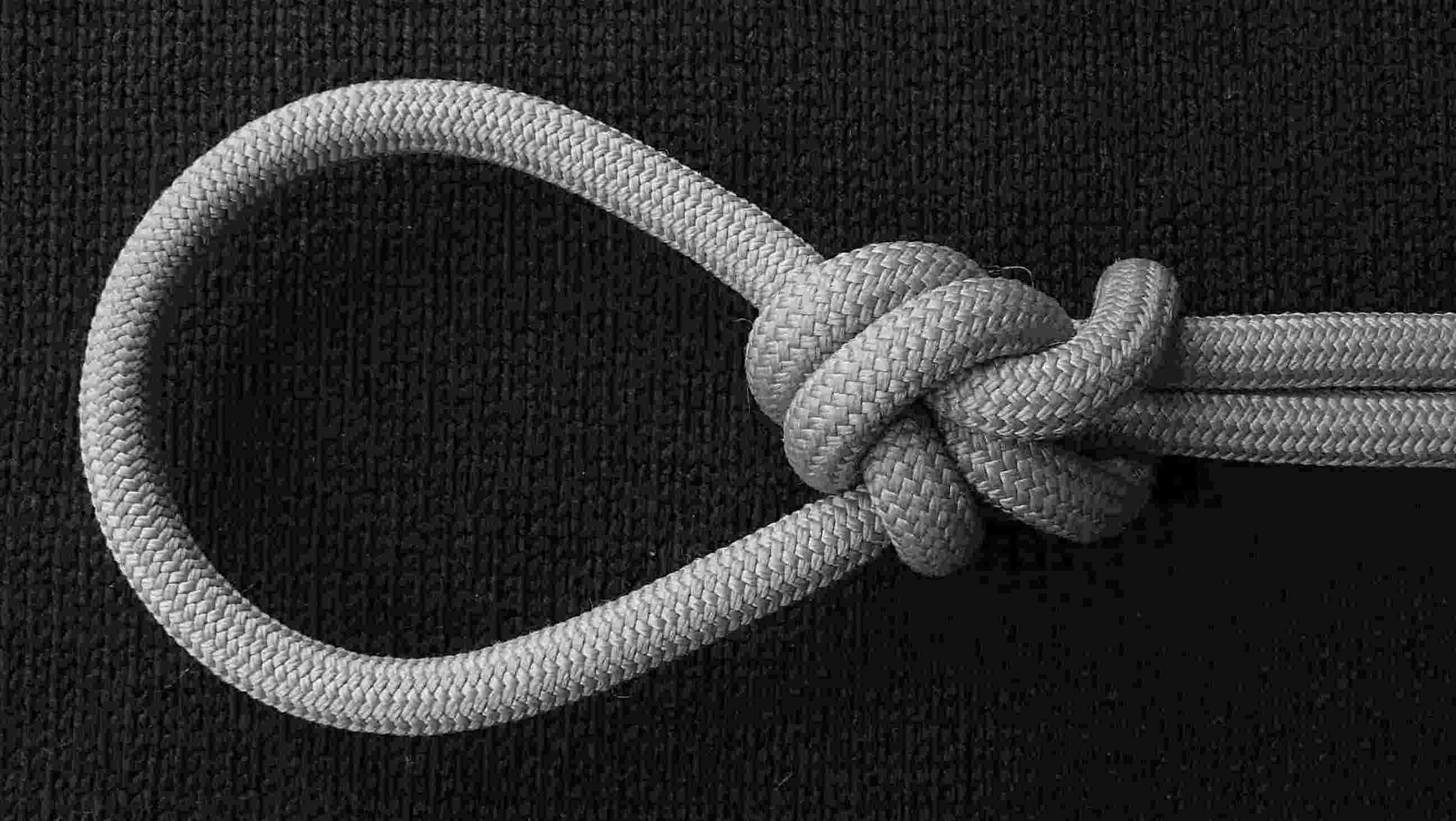
The rear view.
What about this?
Please, look at the attached pictures…
but if we tie the knot from the other side we obtain a good “double-strand right-hand bowline”.
The TIB tying method is similar…
bye,
s.
The “nipping structure” became too convoluted, and I do not see what it is gained by that : we do not need to nip the knot tied on the Standing part after the eye ( the “collar structure” ) any more than it is already nipped in the original Med. bowline - in fact, we do not need to nip it at all, because it is t o p o l o g I c a l l y linked / attached to the “nipping structure”, so it can only slip through it if the line of the “collar structure” is cut in two ! ![]()
This loop can not be considered a “bowline” any more : it is a double line crossing-knot-based loop. It is a secure knot, as most crossing-knot-based lops are, but the knot tied on the Standing Part before the eye is much more convoluted / complex than the knot tied on the Standing Part after the eye, and this in never a good thing regarding strength : IMO, we should try to retain a "balance’, an equilibrium between how tangled is the line in the two knots, because that will probably mean an equilibrium between the forces and the stresses acting inside the whole nub - which is always a good thing regarding strength : we do not want nubs with “weak links”, which will be ruptured well before the others.
The nipping structure is the same, I simply tied a standard bowline (right-hand) and doubled it…
Doubling the knot in this way, maybe the left-hand bowline is better than the right-hand bowline.
I attach 2 pictures with the knot in a loose form
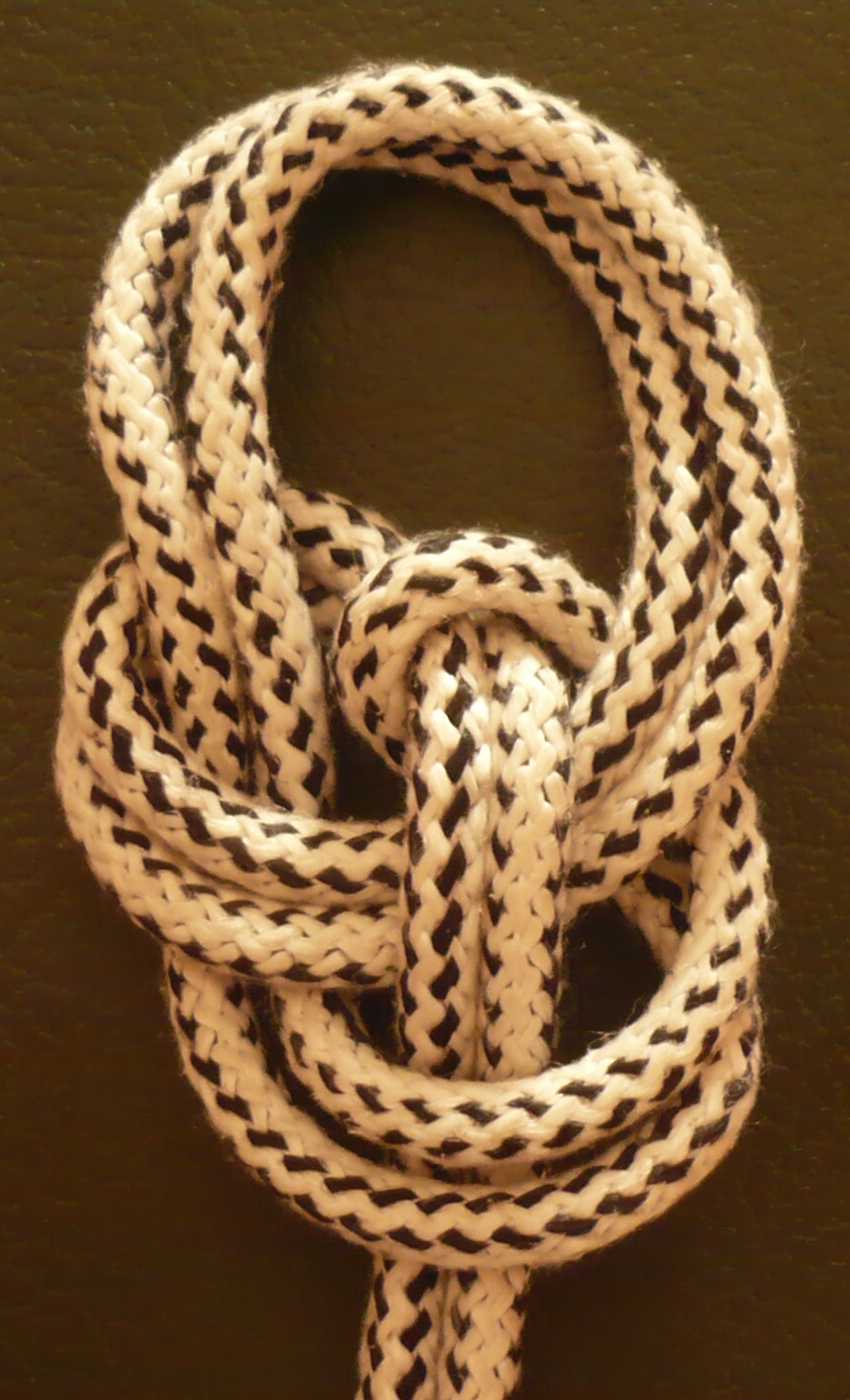
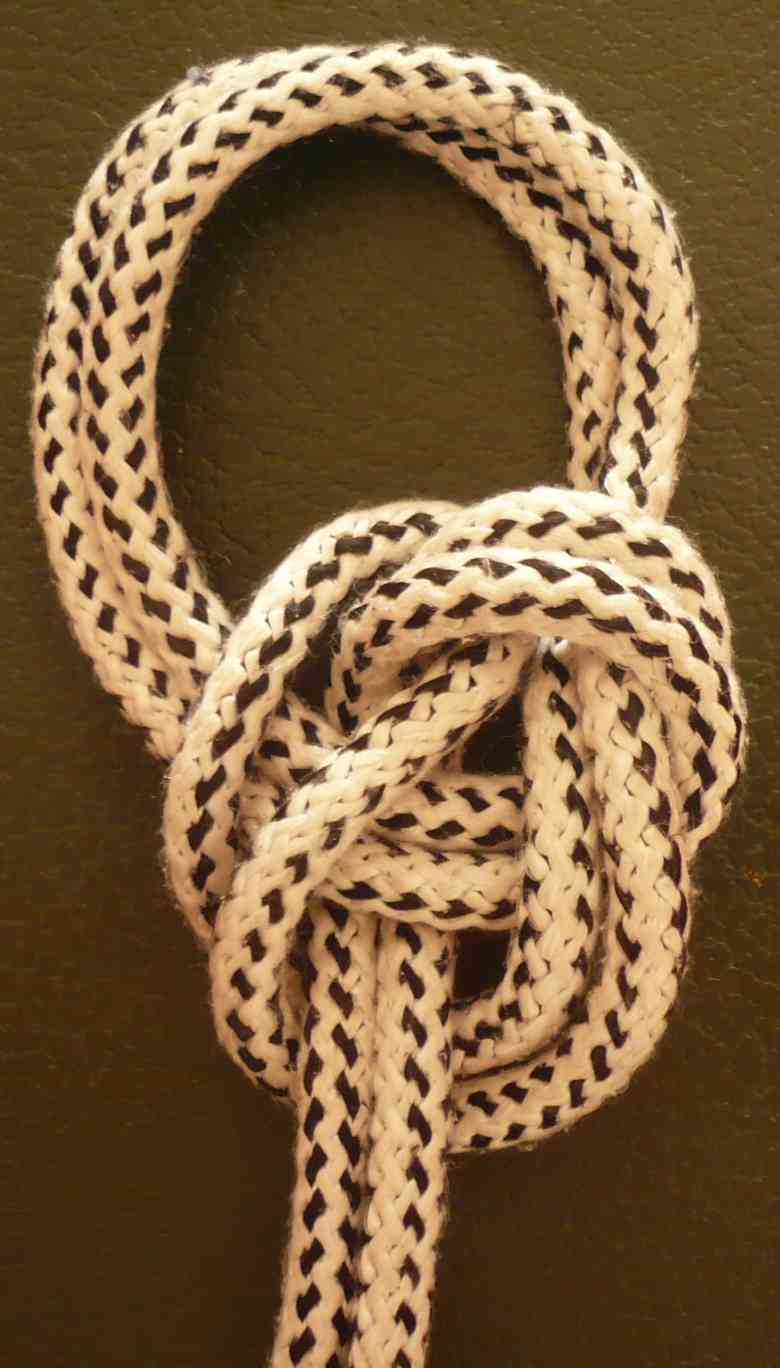
Noope ! ![]() I l o v e to notice that two knots are the same, when people believe that they differ - because I want to understand how knots, in general, “work”, and why, so when I find a real, s t r u c t u r a l similarity, hidden under misleading, skin-deep “formal” appearances, I believe I do something potentially useful. So, to pop out and shout : “It is different !”" It is different !", is not my cup of tea - but when I have to do it, I do it.
I l o v e to notice that two knots are the same, when people believe that they differ - because I want to understand how knots, in general, “work”, and why, so when I find a real, s t r u c t u r a l similarity, hidden under misleading, skin-deep “formal” appearances, I believe I do something potentially useful. So, to pop out and shout : “It is different !”" It is different !", is not my cup of tea - but when I have to do it, I do it.
See the attached pictures, of your Med. bowline II ( let us call it like this, for the moment ).
First thing one should notice, and admire, is the most beautiful side #1, where there is this LOVELY 3-symmetry ! This is a GREAT advantage regarding how easy is to inspect this knot - and it underlines that symmetry is not useful only regarding the structure of a knot ( because it distributes forces and stresses evenly ), but also regarding how easily it can be tied correctly.
Second thing is to notice that the areas where the double-line continuation of the Standing End = the double-line Standing Part before the eye = the double-line “nipping structure”, approaches itself, are more than one. If it approaches itself only once, at one “point”, we have a nipping loop. If it approaches itself two times, at two “points”, we have a crossing knot.
At your knot, as it is dressed in the pictures I had commented on, it approaches itself two times - the second is shown with the two red arrows in the B&W picture. That is why I said it is not looking as a double-line “bowline” any more. It is not the topology of the nipping structure different than it was in the original Med. bowline, it is the geometry, and that is why I had claimed that the two nipping structures are different.
P.S. Perhaps we could say that the Med.II bowline is the “Eskimo” version of the Med.I ? ? ? I am not sure that this is not a far-fetched “similarity”, nor that it is useful…
I think you like this cup of tea too ![]()
thanks for your comment.
Maybe we have to consider the knot (it is one knot) in the attached pictures as the “Eskimo” version of the Med.
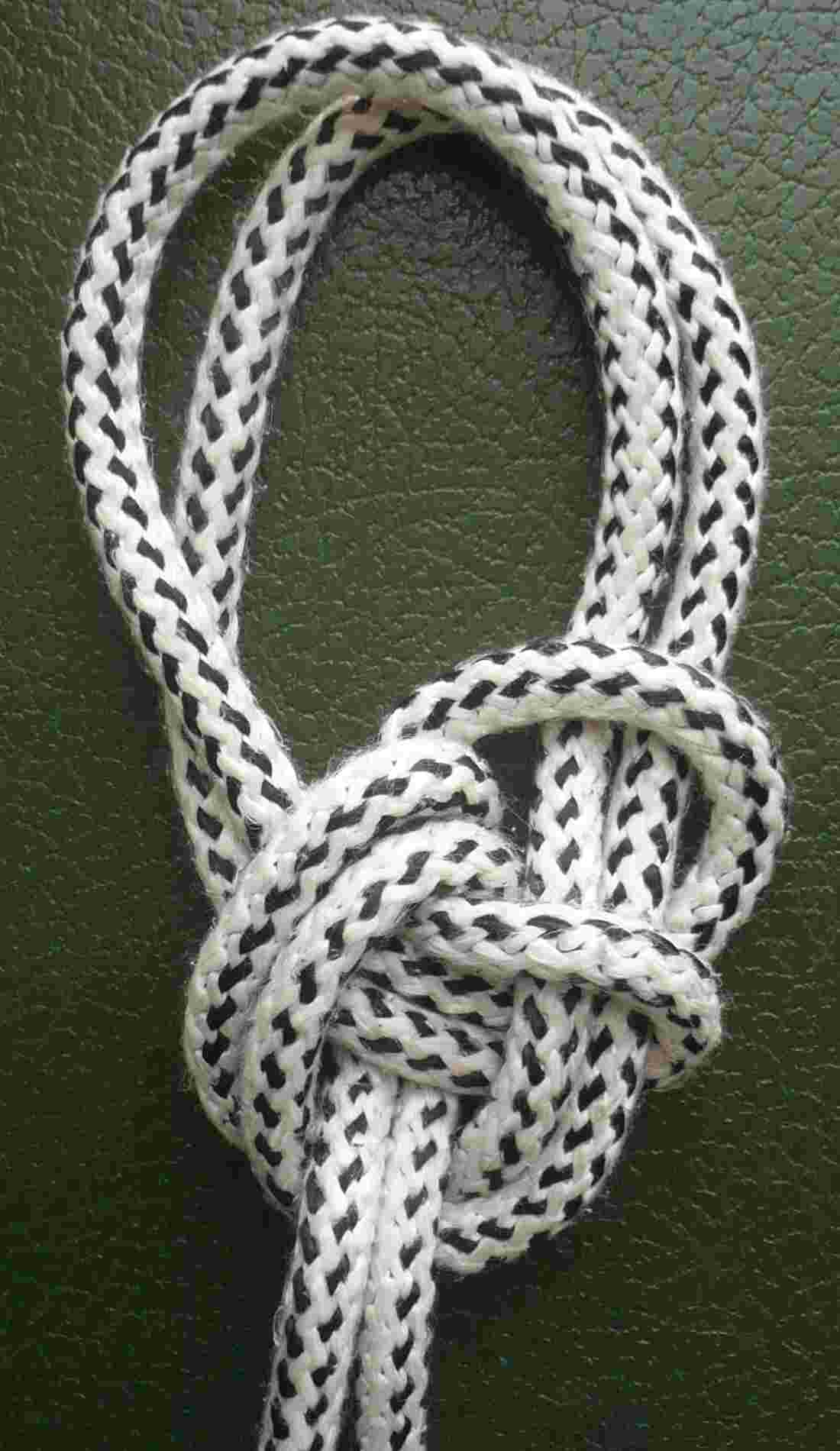
Indeed. However, one advantage of the original Med. bowline is that it is not more complex ( and it can even be considered as more simple ) than the Double bowline on-the-bight. The knot you show is more complex than the Eskimo bowline-on-the-bight :
Yes, you’re right: Med. II and Med. Eskimo are more complex, but the side #1 (as you noted) is beautiful. Furthermore it’s interesting to explore this way of doubling a “bowline” forming “the” bight. Now I’m trying with the myrtle…
ciao,
s.
Their disadvantage is not that they are more complex, but that they are more complex than their “parent” on-the-bight knots : Med Eskimo is more complex than the Double Eskimo on-the-bight, and Med II is more complex than the original Med - although, the original Med is not more complex ( and, perhaps, it may seen as more “simple” ), than the Double bowline-on-the-bight.
Our judgement should be comparative, not “absolute”.
Using the “Med. method” of doubling bowline, here it is:
the Med. pseudoMyrtle (!?)
(the pseudo-myrtle (I don’t know if there is a name for this knot) is illustrated in the second picture).
ciao,
s.
p.s. the Med. pseudoMyrtle is more complex than…? I don’t know! but whilst I was trying to “unTIB” the Med. pseudoMyrtle I obtained the standard double bowline on the bight, so it is more complex than the standard double bowline
